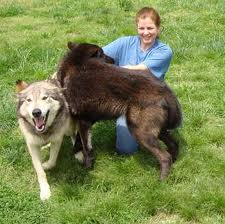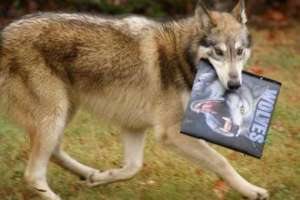
I’m excited to welcome a brave and talented guest today whose writing has led her to read with the wolves! Robyn Hood Black is the author of two children’s books, Wolves (Dalmatian/Intervisual Books) and Sir Mike (Scholastic/Children’s Press). She’s had poetry published in Welcome Home and Hopscotch for Girls, and she also has poems slated to appear in Berry Blue Haiku and Ladybug. In addition, Highlights Magazine will publish Robyn’s short story in 2011. I met Robyn at an SCBWI conference, and I’m thrilled she’s come to share with us her expertise!
Hi Robyn. How did you get started writing books for children?
As soon as I was old enough to put crayons to paper, I was making up and illustrating stories. I’ve always wanted to write children’s books. I made a (not so good) one as an art project in high school, and I think my first submission to a publisher was while I was in college. That manuscript was not so good, either!
I sought out opportunities to write at every stage of life, from school newspapers to community newspapers to church newsletters and local magazines, and I’m grateful for what I learned with those bylines.
It sounds like you’ve experienced it all in the world of writing! Do you think it’s helpful to build up a variety of writing experiences before tackling books?
For me, it was. When writing for any kind of publication, you have to think about audience and deadlines and making every word count — and working with an editor. When I got the contract to write WOLVES, which was part of a series, it had a very tight deadline. A writer friend looked at what the publisher wanted and the time frame, and she shook her head, saying, “I would be so overwhelmed…!”
I laughed and said I would be drawing upon my inner newspaper reporter — I knew the person who could crank out eight or more feature stories in a week in her 20s was still inside somewhere. And she was.
Wow — writing eight stories a week is a lot to keep up with! Were you influenced by any particular authors of children’s books along your writing journey? Who were your favorite authors when you were a child?
I remember riding my bike to the library as a kid growing up in Florida, and it always seemed like a magical destination. When I was very little, I loved P.D. Eastman’s Are You My Mother? and The Poky Little Puppy by Janette Sebring Lowrey. I loved Jean de Brunhoff’s Babar books.
Oh, my kids love those same books too!
Also, I would play those Disney storybook albums (kids today might not even know what an LP looks like!) and act out the stories as I turned the pages and took in that wonderful art. I remember appreciating Judy Blume’s Are You There God? It’s Me, Margaret when I was the right age for it, and Emily Neville’s It’s Like This, Cat.
I collected fiction and nonfiction books about animals, too, such as Walt Morley’s Kavik the Wolf Dog, all kinds of cat books, and Joy Adamson’s lion books. I still have most of those books, and the records!
What a wonderful collection you must have! OK. Let’s talk about WOLVES! Over the summer, I read Jean Craighead George’s 1973 Newbery winner, Julie of the Wolves. How did you begin working with wolves?

Jean Craighead George has always been one of my heroes. She turned 91 this summer, I believe. Getting the contract to write a book about wolves was a dream come true. I learned so much during the research (and I’m still learning!).
While writing the book, I wanted to observe/photograph/sketch real wolves. I discovered that the Chestatee Wildlife Preserve in Dahlonega, Georgia — not far from my home — had a couple of wolves at that time. I visited them, and the next spring (2008) met two female pups born there, Juno and Luna.
They were four weeks old, and I immediately filled out the paperwork to volunteer there. I’ve worked with animals my whole life — mostly my own and also as a volunteer — and I’ve been lucky to have friends who are professional trainers.
I see the cover of your book, which is WOW KINDA SCARY, and then I see pictures of you hanging out with wolves. Have you ever felt like you were in any danger?

That is a striking picture, huh?! Illustrator Colin Howard did a terrific job. To answer your question, No, BUT — I always stress to kids that wolves are not dogs! Our dogs came from wolf ancestors, but wolves are still wild, even those in captivity. I respect that about them and am conscious about things like body language, the tone of my voice, energy level, and personal space.
We used to have horses — one was particularly difficult; hence the relationship with one particular trainer friend! — and I find working with wolves is more like working with horses than with pet dogs. Instincts are always at the forefront. Dogs have been domesticated over thousands of years; wolves have not.
As an example, one of the worst things about tearing my Achilles this past spring was that I could only interact with Juno and Luna through a fence when I finally made it back out there. My dogs at home were happy to hang out with me on the couch and not count my weakness and vulnerability against me. But around predators, even socialized ones, you have to respect their natures.
I’m confident with the wolves at the preserve because I’ve volunteered with them since they were young pups, but I keep in mind that they are wolves. By the way, a male wolf pup came to the preserve this summer, and he’s been a joy to work with.

Can you tell us a few interesting facts you learned while writing your book on wolves?
Wolves and people have much in common. Both live in social groups with dominance hierarchies, and they work (hunt) cooperatively. They are fiercely loyal to their families. In a wolf pack, usually the top male and female are the only ones who breed, and their pack is really an extended family, usually including pups from previous litters who haven’t struck out on their own yet to form new packs, and sometime an outside member or two.
All the pack members help raise the litter of pups born in the spring. Wolves are wild about pups! The older pack members tolerate their antics and help discipline them when necessary. Another interesting fact — did you know most wolf hunts don’t result in a meal for the wolves? Wolves offer lessons in persistence, something very helpful for writers seeking publication!
Hey, that is so cool! I’m going to have you and your wolves to thank if I ever persist long enough to publish a children’s book! Robyn, I know your school visits are very popular. What’s it like for you to give a workshop at a school?
I LOVE school visits. They take a lot of preparation and energy, but something magical happens during that sharing time with young readers and writers. It’s always a privilege to explore stories and the creative process with kids.
Can you give us any tips on what makes a good school visit?
Starting small is a good way to get your feet wet — volunteering to lead a writing activity in your child’s classroom, for instance. Teachers usually love exposing their students to folks who are passionate about reading and writing and who have something to offer which reinforces what they are teaching.
Your first school visit doesn’t have to be a full-fledged paying author visit with 400 kids on a gym floor. Those are fun, too, but you can work up to that! I always enjoy tailoring programs to specific things the kids are learning. If I can present concepts in a fun and different way, everybody wins!
In a memorable school visit, the author’s passions — for writing and for subject matter — shine through, and he or she is comfortable leading a group of enthusiastic children. Kids, like wolves, thrive on leadership and mutual respect!
You make school visits sound like fun! Do you have any advice for moms who would love to write books for children, but need to carve out a little time and space to create?
First, don’t give up! When I was a stay-at-home mom with small children, sometimes the best I could do was keep my little toe in the waters of writing. But parenting is the most important job on the planet, and when kids are small, it doesn’t leave room for much else (unless maybe you have lots of family members around who love to babysit). Even though my kids are teenagers now, that family-work balance can still be a challenge.
That said, it’s important to take your talents/gifts/interests seriously, or nobody else will. (They still might not even if you do!) If you can leave Dad or Grandma or a trusted friend in charge for a weekend, a conference can be a wonderful break from your daily demands and source of inspiration, for now or for later.
Just think — 24 to 48 hours of adult conversation about children’s books? Ahhhhh. I’ve been a regular conference attendee since my kids were little, and the focused attention to craft not only helps my work, but the networking and friendships continue to enrich my life.
On the home front, even if you can eke out only a few minutes a day to write a paragraph or jot down project ideas or read an article on publishing, take that time. And know that some other “stuff” will not get done. But you’ll be modeling the nurturing of your own gifts for your children, and that’s valuable.
Your husband and children, wonderful as they are, are probably not going to tell you, “Honey/Mom — the world really needs your creative vision. Here, we’ll do all the laundry and grocery shopping and remain quietly in the background while you finish your story.” So you have to believe in yourself and claim a little territory!
Ha! You’re too funny! That does sound like a dream conversation! Can you tell us your number one secret for getting published?
Still working on that …. Actually, speaking of conferences, I have to say getting involved in SCBWI (the Society of Children’s Book Writers and Illustrators) is my number one piece of advice to anyone who wants to jump into the world of writing and/or illustrating for children.
Our Southern Breeze region is very active with lots of dedicated, generous folks. Having said that, it’s important to remember that all the networking in the world — all the blogging, web-surfing, book reviewing — is not a substitute for actually writing.
The most important thing to do if you are serious about writing for children is to develop your craft by reading lots of books in the genres you want to write, and then to write, write, write.
Thanks for this great advice! Here’s one last question, and then I’ll let you get back to your own writing! What are you working on these days?
I recently finished my first novel (round one, anyway) and have sent it off to the first editor on my list. It’s historical fiction and required tons of research! I’ll keep you posted if it receives any interest.
I have a couple of picture book projects I’m hoping to find homes for, and I continue to write and submit poetry. I’m fortunate to have some great critique group partners, and my husband and kids are used to my shoving new works under their noses for feedback. My daughter just left for college, and I’ve already emailed her some works-in-progress!
Thank you SO much, Robyn! You’ve given all of us some wonderful, practical ideas on how to give our creative life the push it needs to meet the real world of publishing. We wish you the best with your future endeavors!
Thank you again for having me, and best wishes in your parenting and writing!
Please visit Robyn Hood Black’s website to keep up with her exciting world of writing. You can also hear Robyn speak IN PERSON at the upcoming SCBWI Southern Breeze Writing & Illustrating for Kids Conference! She’ll be co-presenting two workshops with writer and media specialist Sharon Wright Mitchell on breaking into magazines and how to create successful school visits that tie into curriculum.





